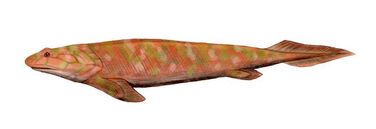
| Panderichthys | ||||
|---|---|---|---|---|
| Name | Panderichthys | |||
| Order | Sarcopterygii | |||
| Suborder | Tetrapodomorpha | |||
| Period | Late Devonian 380 million years ago | |||
Panderichthys rhombolepis is a 90–130 cm long fish from the Devonian period 380 million years ago, (Frasnian epoch) of Latvia. Discovered in 1941, it is named after the German-Baltic palaeontologist Christian Heinrich Pander. It has a large tetrapod-like head. Panderichthys exhibits transitional features between lobe-finned fishes and early tetrapods such as Acanthostega, and is considered the most crownward stem fish-tetrapod with paired fins. The evolution from fish to land dwelling tetrapods required many changes in anatomy and physiology, most importantly the legs and their supporting structure, the girdles. Well preserved fossils of Panderichthys clearly show these structures in transition,[1] making Panderichthys a rare and important find in the history of life. One of the major changes in the appendicular skeleton during the transition from water to land was a shift in locomotory dominance from pectoral to pelvic appendages. Panderichthys is evidence of this because its morphology shows that the fin to limb transition began in the pectoral appendages and only later occurred in the pelvic appendages. Panderichthys is a good example of a transitional state in tetrapod evolution because its pectoral girdle shows derived characteristics while its pelvic girdle retains ancestral ones. Even though Panderichthys does not show the shift in locomotory dominance, it seems as though it was capable of some kind of shallow water or terrestrial body flexion locomotion and had the ability to prop itself up.[2]

Panderichthys
Fish like Panderichthys were the ancestors of the first tetrapods, air-breathing, terrestrial animals from which the land vertebrates, including humans, are descended.
Recent reexamination[3] of existing Panderichthys fossils using a CT scanner shows four very clearly differentiated distal radial bones at the end of the fin skeletal structure. These finger-like bones do not show joints and they are quite short, but nonetheless show an intermediate form between fully fish-like fins and tetrapods.
In January 2010, Nature reported well-preserved and "securely dated" tetrapod tracks from Polish marine tidal flat sediments approximately 397 million years old.[4] Therefore, Panderichthys can only be a "late-surviving relic",[5] showing traits that evolved during the transition from fish-like creatures to tetrapods, but whose date does not reflect that transition. The tracks "force a radical reassessment of the timing, ecology and environmental setting of the fish–tetrapod transition, as well as the completeness of the body fossil record."[4]
Discovery and history[]
Description[]
Panderichthys was about a meter long, a little bit larger at the max, and was a relatively aquatic genus. Like the modern fishes that swim in lakes, ponds, and oceans today (Holocene period), it would have had similar feeding habits, and probably ate smaller animals at one point as well.
Paleobiology[]
Classification[]
Paleoecology[]
Gallery[]
Panderichthys/Gallery